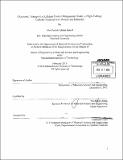| dc.contributor.advisor | Yet-Ming Chiang. | en_US |
| dc.contributor.author | Ransil, Alan Patrick Adams | en_US |
| dc.contributor.other | Massachusetts Institute of Technology. Department of Materials Science and Engineering. | en_US |
| dc.date.accessioned | 2013-11-18T19:08:54Z | |
| dc.date.available | 2013-11-18T19:08:54Z | |
| dc.date.copyright | 2012 | en_US |
| dc.date.issued | 2013 | en_US |
| dc.identifier.uri | http://hdl.handle.net/1721.1/82324 | |
| dc.description | Thesis (S.M.)--Massachusetts Institute of Technology, Dept. of Materials Science and Engineering, February 2013. | en_US |
| dc.description | Cataloged from PDF version of thesis. | en_US |
| dc.description | Includes bibliographical references (p. 86-90). | en_US |
| dc.description.abstract | Potential routes by which the energy densities of lithium-ion batteries may be improved abound. However, the introduction of Lithium Nickel Manganese Oxide (LixNi1i/2Mn3/2O4, or LNMO) as a positive electrode material appears to be one of the shortest. LNMO is a high-voltage material, with a voltage of 4.7V, and thus offers a significant energy density boost without straying far outside of the stability window of common carbonate-based electrolytes. Furthermore, it would serve as a drop-in replacement for the positive electrode materials already used. In order to best engineer such devices to take full advantage of the intrinsic transport properties of the material, it is important to develop an understanding of what these transport properties are. For a deep understanding of the material such properties must be related not only to material performance but to the processing conditions and atomic structure of the material. The material may be processed such that it belongs in either the P4 332 or the Fd3m space group, exhibiting either order or disorder respectively of Ni and Mn cations. Such processing has a great effect on the concentrations of electronic charge carriers, and thus an effect on the DC electronic conductivity of the material. This conductivity was thus measured for both processing conditions as a function of the lithiation state, and then related to carrier concentrations via the small polaron model for charge conduction. In such a way, the links betweer processing, structure and properties of this material were elucidated. It is hoped that this work will be built upon in order to engineer the high energy-density batteries of the future. | en_US |
| dc.description.statementofresponsibility | by Alan Patrick Adams Ransil. | en_US |
| dc.format.extent | 90 p. | en_US |
| dc.language.iso | eng | en_US |
| dc.publisher | Massachusetts Institute of Technology | en_US |
| dc.rights | M.I.T. theses are protected by
copyright. They may be viewed from this source for any purpose, but
reproduction or distribution in any format is prohibited without written
permission. See provided URL for inquiries about permission. | en_US |
| dc.rights.uri | http://dspace.mit.edu/handle/1721.1/7582 | en_US |
| dc.subject | Materials Science and Engineering. | en_US |
| dc.title | Electronic transport in Lithium Nickel Manganese Oxide, a high-voltage cathode material for Lithium-Ion batteries | en_US |
| dc.title.alternative | Electronic transport in LNMO, a high-voltage cathode material for Lithium-Ion batteries | en_US |
| dc.type | Thesis | en_US |
| dc.description.degree | S.M. | en_US |
| dc.contributor.department | Massachusetts Institute of Technology. Department of Materials Science and Engineering | |
| dc.identifier.oclc | 861617665 | en_US |
